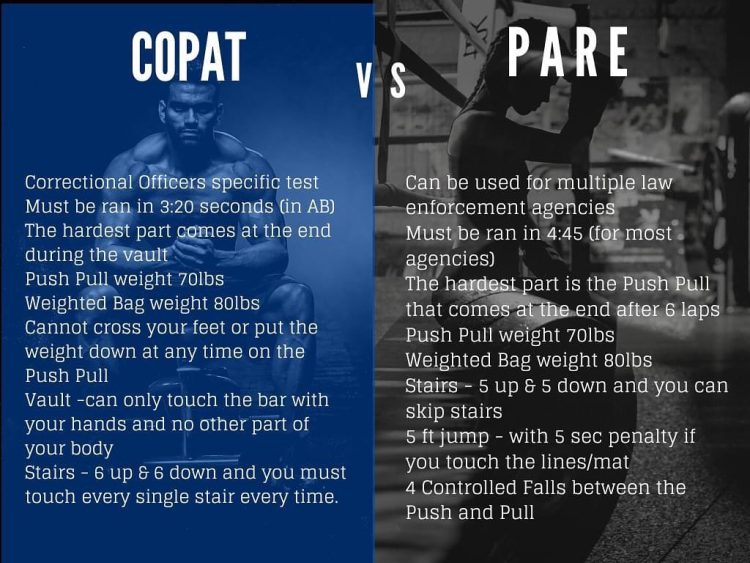Aspiring correctional officers and law enforcement candidates embark on a journey that demands not only mental acuity but also physical prowess. Central to this journey are the challenging physical fitness tests, which serve as crucial benchmarks for evaluating candidates’ abilities to meet the demands of their roles. In this blog post, we delve into the key differences between the Correctional Officers Physical Abilities Test (COPAT) and the Physical Abilities Requirement Evaluation (PARE) for law enforcement applicants, and offer insights on how to train effectively for both.

Understanding the Tests
Correctional Officers Physical Abilities Test (COPAT):
The COPAT is designed to assess candidates’ physical readiness for the unique challenges of working within correctional facilities. The test includes tasks such as climbing multiple flights of stairs, pushing and pulling weights of 70lbs, and navigating tight and confined spaces. Given the nature of correctional work, the COPAT emphasizes functional strength, agility, and endurance. Learn more about the COPAT requirements and check out the map of the obstacle course!

Physical Abilities Requirement Evaluation (PARE):
The PARE, on the other hand, is tailored to evaluate candidates’ fitness for externally based law enforcement roles, which often involve dynamic and physically demanding situations. The test simulates tasks such as running, obstacle negotiation, and use of force scenarios, reflecting the varied challenges officers may encounter in the field. The PARE assesses not only physical fitness but also mental resilience and tactical skills. Learn more about the PARE requirements and check out the map of the obstacle course!

Training Strategies
- 1. Assess Specific Requirements: Before diving into training, it’s crucial to understand the specific components of each test. Reviewing the official test protocols and seeking guidance from professionals such as the experts at Blue Line Fitness Testing can help tailor your training regimen to address the unique demands of COPAT and PARE. Book a practice test with us to see first hand, the challenges that each test requires. A practice test with Blue Line Fitness Testing includes a full walk through of the course, including tips and tricks on ways to maximize your efficiency and minimize your time, time to practice and play around on the obstacles to ensure you are fully comfortable on each section, and then a full run through of the course. A written evaluation will also be conducted and reviewed with you after your test, allowing you to see where you struggled on the course and where you excelled. From there, the experienced staff at Blue Line can build out a training program for you to help you tailor your training to the test you need to pass. Your practice test should be booked approximately 6 weeks before your official test to allow you the appropriate time you will need to gain the fitness level that is necessary to pass these grueling tests.
- 2. Focus on Functional Fitness: Both COPAT and PARE emphasize functional movements that mimic real-world scenarios. Incorporate exercises such as squats, lunges, push-ups, and planks to build overall strength and stability. Additionally, include cardio activities like running, cycling, and HIIT workouts to enhance endurance. Check out our weekly classes to improve your fitness and get an opportunity to practice on the obstacles in the same environment where you will be taking your official test!
- 3. Practice Task-Specific Skills: To excel in the COPAT, dedicate training sessions to tasks like stair climbing, pushing/pulling weighted objects, and navigating the 3 foot vault. Exercises like burpees, shuttle runs and HIIT training are ideal. For the PARE, focus on agility drills, obstacle courses, and scenarios that simulate law enforcement challenges such as pursuit and apprehension.
- 4. Prioritize Recovery: Balancing training intensity with adequate rest and recovery is essential to prevent injury and optimize performance. Incorporate rest days into your training schedule, prioritize proper nutrition, hydration, and sleep, and consider incorporating techniques like foam rolling and stretching to alleviate muscle tension. Try our weekly yoga classes to incorporate recovery days and mindfulness during your preparation!
- 5. Simulate Test Conditions: As the test date approaches, simulate the test environment as closely as possible during training. Practice completing the tasks within the specified time limits and under conditions that replicate the physical and mental stressors you’ll encounter during the actual test. Join us every Saturday for our Open Gym sessions, a dedicated hour for you to practice on any of the obstacles you need to or run laps of the course to ensure you are fully prepared and ready to ace your test!
WE CAN HELP YOU PASS ANY FITNESS TEST IF YOU WANT TO ENTER LAW ENFORCEMENT IN CANADA.
The journey to becoming a correctional officer, sheriff, peace officer, CBSA officer or any other law enforcement officer demands dedication, discipline, and a commitment to physical fitness. By understanding the nuances and key differences of tests like COPAT and PARE and tailoring your training approach accordingly, you can maximize your chances of success. Remember, consistency, and perseverance are key. Train smart, stay focused, and embrace the challenge as you work towards your goal of serving and protecting your community.
Blue Line has experienced instructors and certified coaches who know exactly how to get people into the physical and mental condition they need to pass their PARE, COPAT, POPAT, SOPAT or APREP as part of any law enforcement entrance testing protocols.
Are you ready to run and pass your Fitness Test? Contact us today to start your journey towards your law enforcement career.
For more information on any of the law enforcement testing Blue Line offers, check out these pages and posts:
THE IMPORTANCE OF BEING PREPARED: 5 TIPS FOR EXCELLING IN LAW ENFORCEMENT FITNESS TESTS
TOP 10 EXERCISES TO ACE YOUR PARE OR COPAT TEST
How the Pass the PARE in Alberta
Sirens, Slammers and Service – A podcast for first responders






